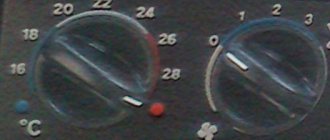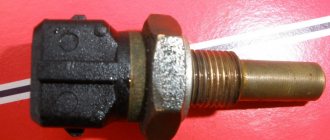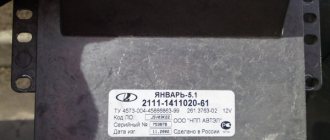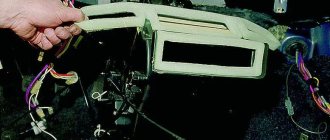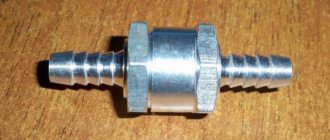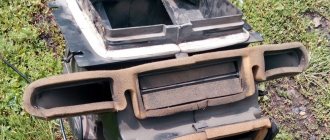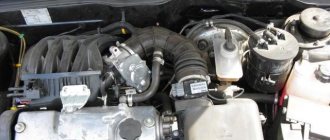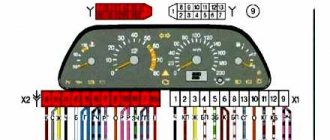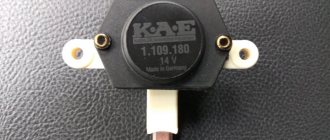Why doesn't the stove work on the VAZ 2114? This is a question many car owners ask themselves. And how to make the VAZ 2114 warm?
Unfortunately, the heating system of the domestic automobile industry still leaves much to be desired. This issue is especially relevant in winter. After all, being cold is not only unpleasant, but harmful, even dangerous to health. And here we are not only talking about the driver’s hypothermia, everything is clear about this. Glasses with a faulty heating system quickly freeze and become covered with frost and ice. Visibility on the road for the driver in such conditions is negligible.
To find out why the stove on a VAZ 2114 does not work, you first need to understand how the stove on a VAZ 2114 works.
Heating in the interior of the VAZ 2114 is arranged according to the classic principle of the line of Samara cars.
Heater fan diagram for VAZ 2114, 2115, 2113.
And so, here is a list of all components of the scheme:
- Mounting block (aka fuse block).
- Egnition lock.
- Ignition switch relief relay.
- Heater fan speed switch.
- Additional resistors.
- Stove motor.
- Rear window heating switch with warning lamp.
- Rear window heating element.
The scheme works as follows. When you turn the key in the ignition switch (2), its unloading relay (3) is turned on. The unloading relay supplies power to fuse f7 in the mounting block (1). After the fuse, power goes to the rear window heating switch (7) and the fan speed switch (4), which distributes which of the resistors (5) the power will go to next. Output 1 from the switch (4) corresponds to the slowest blowing speed, and output 3 goes directly to the heater motor (6), i.e. highest blowing speed.
Reasons why the VAZ 2114, 2115, 2113 heater motor does not work.
The reasons why a fresh flow of cold air in summer or a hot stream in winter does not come from the air ducts of your VAZ 2113, 2114, 2115 can be of two types:
Let's look at them in more detail.
Mechanical reasons why the VAZ 2114, 2115, 2113 heater fan does not work.
First of all, mechanical reasons include clogging of the air duct.
As you can see in the photo, leaves, branches and other debris get under the casing and clog the air duct of the heater motor. Debris can get into the section with the blades itself and jam the stove fan. Usually before this, a whistle or grinding noise is heard from under the soot space.
Mechanical reasons for the inoperability of the stove motor include jamming of the blades due to improper installation of the stove fan housing. When removing the stove motor, the latches securing the two parts of the housing are often damaged. And if these parts are not firmly fixed to each other, then there will be a gap between them and the air flow that should go into the cabin will fall into this gap. Also, parts of the housing may generally jam the motor blades, then it will not spin at all.
Problems with the heater fan from the electrical part.
In this section, we will consider the circuit to the VAZ heater fan by components.
Fuse.
Let's follow the scheme given at the beginning of the post. If your heater fan does not work together with the heated rear window, then the problem is 100% in the fuse. Check fuse f7 in the mounting block , if it is ok, then use a multimeter to see if the plus is coming to it from the ignition switch unloading relay. To do this, with the ignition on, place one multimeter probe on the fuse and the other on the car body. If everything is in order, look at the circuit from the fuse to the speed switch and the heating switch.
Heater fan speed switch.
We figured out the fuse - let's move on. And then we have the stove motor speed switch . To check it, remove the connector from it. The connector has three inputs nearby and one is located, as if separately from them. We connect any of these three inputs with a wire to the one that stands separately. If the motor starts working, then the speed switch is to blame; if not, we move on.
Additional resistors.
If the fan works, but only at the third (fastest) speed, then additional resistors . In the third mode, power is supplied directly to the fan, bypassing additional resistors, so it does not work in other modes.
Heater motor VAZ 2114, 2115, 2113.
If checking all the components listed above shows that they are working, the reason is in the stove motor . Most likely it is burned out or has a bad mass. To check, we remove it (read how to do this here) and connect it directly to the battery (the black wire screwed to the body is a minus). If it works, it's a bad mass. If it doesn't work, we change the motor.
Source
VAZ 2115 heater fan stopped working
Why doesn't the stove work on the VAZ 2114? This is a question many car owners ask themselves. And how to make the VAZ 2114 warm?
Unfortunately, the heating system of the domestic automobile industry still leaves much to be desired. This issue is especially relevant in winter. After all, being cold is not only unpleasant, but harmful, even dangerous to health. And here we are not only talking about the driver’s hypothermia, everything is clear about this. Glasses with a faulty heating system quickly freeze and become covered with frost and ice. Visibility on the road for the driver in such conditions is negligible.
To find out why the stove on a VAZ 2114 does not work, you first need to understand how the stove on a VAZ 2114 works.
Heating in the interior of the VAZ 2114 is arranged according to the classic principle of the line of Samara cars.
Malfunctions and diagnostics
As you can see, the heater is designed primitively. The operating principle is also very simple. But even so, the stove does not work on most VAZ cars (2115 VAZ is no exception). Let's look at typical faults.
Determining whether the heater has started working or not is very simple. If you turn on the heater in the cabin while the engine is running, the fan should start. If this does not happen, then something has happened and there will be no heat because the stove is not functioning.
In addition, the fan in the stove may not work, cold air enters the cabin, the damper does not work, there are antifreeze leaks, the stove makes various extraneous sounds, and smoke or steam comes out of the air ducts. Sometimes the stove in the VAZ 2115 does not work, it does not blow for no reason.
What does the heating system consist of?
- Faucet.
- Radiator.
- Fan.
- A special resistor that controls the power of the fan motor.
- Dampers through which air is supplied to the cabin.
- Optimal power position switch.
When the system is working properly, coolant enters the heater radiator through the heater tap. The driver controls the temperature of the air entering the cabin independently when he opens and closes this same tap. Heat is created by the coolant that reaches the radiator. When the engine is hot, the coolant temperature rises to 95 degrees!
The Samar stove has three operating modes. The fan speed depends on them and is controlled by the driver independently via a position switch. Depending on the position of the tap we already know, cold or warm air blows into the cabin. The air flow is directed by dampers. The oven damper is adjusted manually.
What causes heating system breakdowns?
Blown fuse
It would seem like a primitive malfunction - you just need to replace it with a new one. However, this problem has a “second bottom”. The fuse clearly deteriorated due to a short circuit in the system. You will definitely need to find it later.
A little about fuses
In total, there are 2 fuse blocks in the car: the first one is on the left side under the hood, the second one is in the passenger compartment under the panel. Both of these devices affect the operation of certain devices.
Which fuse is faulty will be indicated by a non-functioning device, for example, a windshield wiper. To get to the faulty fuses, you need to remove the block cover while simultaneously pressing the special latch.
As we know, there are two fuses, and only one of them is faulty. With good vision, an attentive driver can easily distinguish a burnt-out part from a intact one. In the core of the part on the blown fuse, the contact line will be interrupted, but for the adjacent, serviceable part, it will be continuous. If you can’t determine it offhand, then you can leave the fuse in place and at the same time turn on a non-working circuit, for example, dimensions. If there is voltage on one side and not on the other, the fuse is faulty and has burned out.
If fuses burn frequently, you should pay attention to the wiring. Most likely, there are serious problems with it and it’s time to contact a competent service.
But in our case, with a faulty stove, only one fuse can fail - this is F7. It is he who is attached to the heating system. Its power is 40 A (amps). F7 replies:
- for the stove fan;
- cigarette lighter;
- heat supply to the rear window;
- light in the glove compartment;
- headlight washer (electric motor).
A faulty fuse will cause the oven and all of the above systems to malfunction.
Contact from the mounting block
Also a popular reason why the stove on a VAZ 2114 failed. There may be a faulty wire. In this situation, you should slightly and carefully move the bundle of contacts.
Ignition relay
It can also prevent the heating inside the car from working properly. If there is a malfunction, the relay must be replaced. It is located on the center console.
First and second position
If the heater does not work on a VAZ 2114 in the first and second positions of the switch, the driver will have to drive his car for a long time without heating before the long-awaited warmth begins to enter the cabin. The heating system is designed in this way: in the first and second positions, the electric pulse to the fan comes from a resistor, in the third position electricity goes directly.
What kind of part is this, and what problems can occur with it?
For the car's heating system, an additional resistor provides the best speed. It has two resistance coils and two operating modes. When the first mode starts, the electrical impulse goes through two spirals, and in the second mode, along a resistance spiral. You should look for a faulty resistor at the gas pedal. Repairing a resistor is a rare event. It makes sense if the contacts are burnt. The second correctable fault is a melted block, the one with three tips. It needs to be replaced with a new one. They are available for retail sale.
If the resistor is faulty, then the action algorithm will be as follows:
- Remove the contacts from the found additional resistor.
- Disconnect the fasteners from the resistor.
- Remove the resistor.
- Make sure it can be repaired.
- Repair.
- Put it back in place, going through the procedure in reverse order.
Switch
On a VAZ 2114, the heater does not turn on if its switch is faulty.
- Remove the center console.
- Prepare a lamp with 2 wires.
- Turn on the engine.
- Connect the minus to ground and the plus to the three-phase resistor.
If in this position our lamp shines, it means that the switch is working, and when there is no light, it means that the fuse has blown out or there is an open circuit in the circuit.
It can also cause damage.
FUSE
It’s worth starting to look for the reason from the very beginning. Fuses usually blow. The malfunction is primitive, and you just need to replace the burnt one with a new one. But the fuse failed as a result of a short circuit, and the cause of the short circuit must be found.
This model has two safety blocks. The first can be found under the hood near the left glass, while the second is located in the cabin, under the panel. Two fuse blocks protect the circuits of certain devices.
You can find out which fuse is not working by looking at what is not working yet. For example, if the heater and washer of a VAZ 2115 do not work, then you need to find the fuse that is responsible for the operation of the washers. It is easy to find a burnt element - even an inexperienced driver can easily distinguish a burnt part from a whole one.
Although, due to a non-working heater in these models, there can only be one problem - fuse F7. It is located behind the heater, and the fuse itself is 40 A. It is responsible not only for the operation of the fan, but also for the washer, glove compartment lighting, heated rear window and cigarette lighter.
Stove fan device
If the VAZ-2115 has stopped heating the interior, first let’s figure out how the stove’s operating system works. The structure is simple: the temperature of the air supplied to the cabin is regulated by the heater tap, when opened, coolant (antifreeze) enters the heater radiator, warming up to 95 degrees. By adjusting the fan operating modes from minimum to maximum, you change the speed of the stove, determining the required amount of incoming heat. All that remains is to direct the air flow in the desired direction using the dampers located along the perimeter of the panel of your car.
Cold air into the cabin
This may be due to various malfunctions. What could happen if the VAZ 2115 stove does not work? The reasons are improper replacement of the coolant, depressurization of the cooling system, and a small amount of antifreeze. To remove the plug from the system, you need to remove the heater radiator pipe and add coolant to the maximum. Then start and warm up the engine. The plug will come out on its own under fluid pressure.
Another nuisance is a jammed faucet. This may happen if the valve was not fully opened before, and during operation, scale appeared at its end, interfering with the normal circulation of the coolant. You can unscrew the tap with pliers or replace it.
The fan impeller may be damaged. It should be inspected and, if there is mechanical damage, replaced. If the cabin filter is dirty, then warm air will also not flow into the cabin. The filter needs to be changed.
Possible reasons
What could have happened? There are several most common options:
- The fuse has failed. In our case it is F7 (30A). The problem is simple and at the same time complex - replacing the fuse is easy, but the reason it blows is that there is a short circuit somewhere in the circuit. In this case, it is better to check the entire safety circuit to avoid recurrence of the problem in the future.
- Ignition relay malfunction. This applies to cases where the fan turns on immediately after the engine has warmed up. There is only one way out - replacing the relay itself, located under the dashboard in the center console.
- Poor contact inside the mounting block. An inevitable problem is a consequence of the operation of the car. The problem can be solved quite simply - just go through the block with wires in the mounting block and, if necessary, replace the oxidized elements.
- The heater switch does not work. To check the serviceability of the switch itself, a regular 12-volt light bulb with two wires is enough. You need to remove the central instrument console, turn on the ignition, connect one wire (“minus”) to body ground, and the second to an additional resistor. If the switch is working properly, the light should light up. Otherwise, connect the lamp to the positive wire on the position switch. If in this case the light does not light, then you need to look for an open circuit or replace the faulty fuse.
- The heater fan motor has failed. If, after checking and eliminating all the possible malfunctions listed above, the heating of your VAZ-2115 still does not start working, there are only a few options left. Poor contact of the fan mass, sticking of the brushes or, in extreme cases, burnout of the motor are possible. In any case, the motor must be replaced, since once it fails, it will continue to regularly cause you inconvenience.
Checking the dampers of the VAZ 2110 heater system
The stove system has 2 dampers. The upper one regulates the intake of cold air, and the lower one regulates the intake of hot air from the heater radiator. And when the drive mechanism or the damper itself breaks down, the stove can heat weakly, not heat at all, or fry too much.
Breakdowns of the stove damper can be of different types; firstly, the damper often gets stuck or jams, and secondly, the damper drive (micromotor-reducer) fails. In some cases, the damper warps or jams due to rust, since there are two types of dampers: the old and the new type, the old ones are plastic with a foam rubber seal, and the new one is metal with a rubber seal. Therefore, if you cannot hear the damper moving, you can move it by hand by removing the deflector in the central panel. The problem with metal ones is that they often jam from rust, and plastic ones warp from exposure to hot air. So if, for example, warm air blows into the front window of a VAZ 2110, and hot air blows from the sides and into the legs, then most likely the damper has not completely blocked the air intake from the street. And when the dampers do not move at all, then you need to check the microdetector - the damper drive mechanism.
Replacing the VAZ 2115 stove fan
Removing a faulty fan is not difficult - you only need to have a regular set of tools with you. In the VAZ-2115, the heater unit is located under the hood, directly under the windshield. The procedure is as follows:
- disconnect the terminal (“minus”) from the battery and the power wire (“plus”) directly from the motor itself;
- remove the protective cover of the fan casing, secured with two screws;
- disconnect the ground (the nut located at the bottom connecting to the heater);
- open the casing and unscrew the screws securing the fan and air intake grilles;
- We move the fan towards ourselves a little, removing it from the mount, then turn it 90 degrees and remove it.
The process of installing a new part is carried out in exactly the same way, but in reverse order. After installation, ensure that all fixing screws are properly secured. All that remains is to test the new heating - and you can continue to enjoy the warmth of your car. Good luck on the roads!
Many motorists have encountered the fact that the heater fan on a VAZ-2114 stopped working. There are many reasons for this effect, and they can occur at any time. So, in this article, we will look at the reasons why the heater fan may not work, as well as methods of elimination.
The video below describes the process of troubleshooting and repair in a situation when the stove fan does not work:
Fan motor repair
If the electric motor malfunctions, it should first be removed and then the feasibility of repair should be determined. It is necessary to evaluate the condition of the brushes, armatures, windings, and check the integrity of the wire insulation. The contact area of the brushes on the armature can be cleaned with zero grade sandpaper. You should also pay attention to the bushings and bearings - clean the rubbing parts from dirt and apply lubricant (for example, Litol). All elements with signs of wear must be replaced.
When installing a new heater radiator, it is recommended to pre-treat the pipes with sealant
Possible causes of a malfunction of the heater fan on a VAZ-2114
Heater fan installed on a car
Before eliminating a malfunction that has occurred, it is necessary to establish the causes of its occurrence.
So, according to the experience of many motorists, the most common reasons are:
- Fuse blown.
- Failure of the contact group.
- Relay failure.
- Resistor.
- Switch.
- The fan motor burned out.
Now that the causes have been discussed, we can move directly to elimination methods.
Elimination methods
Many motorists think that a heater fan failure is associated only with a fuse or combustion of the motor that turns it, but this is far from the case. Let's consider all possible reasons in more detail.
Fuse blown
Mounting fuse block where the heater fan fuse is installed
The most common cause of all auto electrician troubles are fuses that fail.
So, in the case of a fan, the first thing you need to do is check the integrity of the fuse. If it is burnt out, it must be replaced with a new one. If this does not help, then you need to look for the reason elsewhere.
The heater fan fuse is marked with an arrow in the diagram.
Heater radiator repair
Usually, if mechanical damage is detected, the stove radiator is replaced with a new one. However, some car owners try to repair cracks and holes using soldering. A copper radiator is quite easy to solder, and it is much easier to restore than an aluminum one. To repair an aluminum heat exchanger, you will need special flux and tinning solder, as well as a powerful soldering iron. The damaged area is first cleaned of dirt and degreased. Then flux and solder are applied to it with a soldering iron. After soldering, it is recommended to check the radiator under pressure to make sure there are no leaks.
